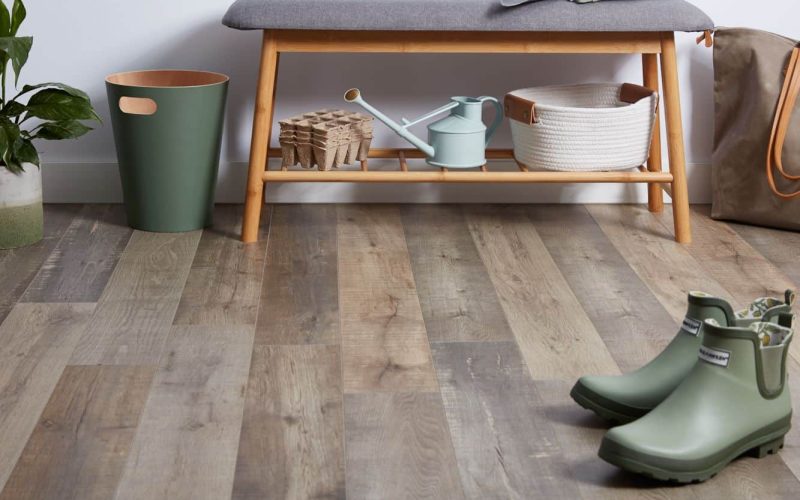Choosing the right flooring can be difficult, especially when on a budget. How can you get the classic look of hardwood or tile without the actual material?
Fortunately, there is another option: Laminate Flooring. Different types of laminate flooring may replicate the appearance of any style or design you have in mind at a fraction of the cost.
Usually, although it has other benefits, laminate flooring won’t feel like the real thing.
What is Laminate Flooring?
Laminate flooring is a type of composite flooring made of synthetic materials. The core layer of plywood or fiberboard forms the base of the floor.
In some cases, an underlay or base layer is added to the bottom of this base layer for additional protection and insulation.
The middle layer is glued to the image layer, which is a high-resolution printed image of real wood, stone, or other material.
Finally, a thin transparent plastic protective layer is added, which protects the lower layers from damage.
Laminate flooring can give you the realistic look of wood, tile, or stone without cleaning dirty seams. It resists burns, scratches, and heat and is easy to maintain.
Laminate flooring was invented in the late 1970s by Swedish flooring company Perstorp but wasn’t widely introduced to the European market until 1984.
A decade later, it became available in the United States. Although it has advantages and disadvantages, it’s still one of the most popular flooring options, and it’s not just for kitchen flooring.
The numerous materials that the different types of laminate flooring can be made to look like make it a good choice for every room in your home.
Believe it or not, people are using it on walls these days, especially in rooms with high humidity, like kitchens and bathrooms.
The different types of Laminate flooring provide popular ways to achieve the look of hardwood or stone flooring without paying the price.
Although it was once considered cheap and artificial, today, it is considered durable, easy to maintain, and—thanks to the growing possibilities of an excellent photorealistic image overlay—high quality.
Different Types of Laminate Flooring
We know you have options when it comes to flooring types. Let’s be honest; laminate flooring has evolved so much in design and style that it suits any room.
With the versatility of laminate flooring, we’re sure you’ll find something to suit your needs.
Below, we’ll walk you through the different types of laminate flooring in terms of installation styles.
Next, we’ll help you understand some terminologies regarding patterns, material imitation styles, texture types, etc.
Different Types of Laminate Flooring Base on Type of Installation
Glueless Click-Lock Flooring
Glueless click-lock is the most popular variant for apartments and bungalows, regardless of the type of abode. It is cheap and widely available.
In addition, it is also very practical and perfect for people without previous experience with flooring. Therefore, it is a common choice for most people.
Unlike most other types of laminate flooring, the Glueless Click-Lock does not require glue or any form of adhesive. Therefore, it is much hassle-free and easier to apply.
On top of that, it saves users from having to deal with sticking and the potential mess of applying glue.
Another great aspect of glueless laminate flooring is the amount of remediation it offers.
For most similar products, there are no returns if you make a mistake when putting them down, resulting in a replacement cost.
Fortunately, the absence of glue allows you to lift and replace it easily. Another feature of the glueless click-lock that makes it so popular is the easy installation process.
Compared to other types of laminate flooring, it is relatively easy to install and will not require a multi-step procedure.
Its dual locking system, thanks to the tongue-and-groove joints on top of the foam underlay, allows you to effortlessly slip it in the lock without worrying about it coming off.
Pre-glued Flooring
People who don’t want to spend too much time laminating their home’s floor will love using the pre-glued version. It’s easy to apply and connects to the floor almost instantly.
Moreover, it is available in many designs and aesthetics that you can choose from and get the one that suits your home environment.
Their strong imitation game is a big reason for the fame and popularity of pre-glued laminate floors. Unlike most types, this product is not composed of hard substances.
These styles of laminate flooring have a pretty paper-like texture and are flexible.
However, the exterior print is superb enough to reproduce many wood and ceramic materials.
The main reason many people love pre-glued laminate floors is that they are easy to install.
The adhesive is attached to it, and you will not need to apply it separately to the product.
Remove the paper covering the glued area and place it on the floor.
The laminate will be ready in minutes. Save any additional flooring to use to accent walls or create headboard alternatives.
One downside you should be aware of before purchasing pre-glued laminate flooring is its poor durability and longevity.
Its fragile material will need to be replaced more often than other types of laminate flooring.
Plus, the paper-like substance means the colors and patterns will fade over time, hurting the home’s aesthetics.
Glued laminate flooring
Although many modern laminate floor designs are on the market today, glued laminate will always be preferred by veteran homemakers.
Nothing is more aged than this variant, and it performs incredibly well. So, if you have previous experience with flooring, go with this type.
One amazing aspect of the glued laminate variation is its ability to enhance the capabilities of laminate flooring.
You’ll have to do it the old-fashioned way, giving you opportunities to develop your skills.
The precision and accuracy required can also be a great way to spend time with your family. Everyone will feel satisfaction after learning and contributing to the project.
One of the characteristics of glued laminate floors that sets them apart is their unmatched durability.
Once you secure it to the ground, you can bet this product won’t budge or move.
Indeed, its firm grip guarantees minimal maintenance. You can move heavy objects in it without worrying about damage.
Since there is no doubt that the use of classic glued laminate has many advantages, its major drawback is the manual application of glue, which can cause sticky situations.
If you’ve never done house flooring before, we recommend that you don’t use it unless you want to mess up your home.
Underlayment Attached Flooring
These glueless planks have an underlayment included, which is ideal for DIY installers as it simplifies the installation process. All you have to do is put them in place.
An underlayment can help smooth out minor imperfections in the subfloor, soften footfalls, and reduce the noise level because of the attached pad.
The underlayment is available in two forms:
- Separated: Felt underlayments or rolls of 3mm polyethylene foam are placed on the base(subfloor) before installation and taped side by side.
- Attached: The manufacturer has already pre-fixed the underlayment under the laminate planks.
Different Types of Laminate Flooring Based on the Material It Imitates
Wood Laminate Flooring
The most popular style, wood laminate flooring, is versatile. This floor consists of thin layers of solid wood, a top layer of wood veneer, and an acrylic finish that makes it strong and durable.
They are thicker planks than other types of laminate flooring, and the models are available in different wood styles.
With their new technology, manufacturers are now offering not only hardwood veneers but also printed types. You will not notice the difference from solid wood.
After years of use, laminate wood floors can be restored to their former glory by light sanding and resurfacing.
Your options for laminate flooring designs are almost endless, especially with wood laminate flooring, in terms of the type of wood you want it to look like.
Let me list some of the options gotten from Home Depot and Lowes’ websites:
Wood options include Acacia, Applewood, Beech, Birch, Brazilian Cherry, Cherry, Chestnut, Elm, Mahogany, Maple, Oak, Pecan, Pine, Teak, Eucalyptus, Fruitwood, Hickory, Tigerwood, and Walnut.
You can get laminate flooring that looks like any hardwood. Of course, you can find even more options if you visit specialty flooring stores and are willing to spend a little more money.
You can even arrange them in herringbone and chevron patterns.
Wood laminate floorings are so strong, visually stunning, and affordable that there is no longer any reason to use real wood flooring.
It’s so common that no one expects the real thing anymore, and it’s nearly impossible to tell the difference just by looking.
They take high-quality scans and photos of the wood planks and print them onto the veneer so that it’s almost indistinguishable.
They use enough scans so that you won’t notice any repeated pattern.
Plastic Laminate Flooring
They are not as popular as laminated wood, although this material can also be versatile.
The plastic laminate is made of fiberboard containing an imposed photo pattern.
Therefore, there are many plastic laminate designs to choose from. Plastic floors should not be used for bathrooms, as this material retains much moisture.
Stone Laminate Flooring
Since laminate is a faux surface laid over wood, you can even find stone laminate floors designed to look like precisely cut and organized slabs of stone or slate, as many call it.
Stone look laminate describes the beauty and realism of real stone. This floor offers rich colors, unique textures, variations in depth and dimension, and ridges and cracks that mimic stone for a completely natural-looking floor.
It’s got that classy look, but it might be obvious in your head that you’re not stepping on a rock.
The difference between appearance and feeling is too significant to be natural to the mind.
But if you appreciate the look, don’t let that put you off. The beauty of the striations and color can be awesome. You can get marble laminate to take it up a notch.
Tile Laminate Flooring
You can also make laminate floorings look like tiles, but be prepared to work with sizes you might not expect.
This is because the actual types of floor tiles are available in different sizes, which differ from the woodcuts.
You can find laminate tile planks that are 12 to 16 inches wide and 3 to 4 feet long, or you can also get individual tiles, usually the pre-glued variety, which range from 12 to 24-inch squares to stick on the ground. They undoubtedly look like ceramic tiles.
Different Types Of Laminate Flooring Based On Pattern
There are several options for choosing a pattern for your laminate flooring, from thin stripes to checkerboard patterns that create a decorative and symmetrical look.
Here are some of the most common patterns:
Traditional Plank
A traditional plank floor sounds exactly like wooden planks of regular width. This laminate flooring is classic and looks great.
Thin Strip Plank
A design with thin planks like Floor Mania can give you a more contemporary look.
Wide Plank
Wide planks give laminate flooring a durable look that will remind you of past building styles.
Herringbone or Chevron Pattern
You can opt for a herringbone or chevron pattern to give the room more character and style. It gives a zig-zag pattern and looks fantastic; it also goes well with many room design options.
Different Types of Laminate Flooring Based on Texture
A laminate floor should have a texture similar to that of the material it is meant to look like, whether it is tile, stone, or wood.
Before buying, you should test the laminates in different lighting conditions to understand how the floor will look at different times of the day and decide in which direction the laminates will be installed.
Rougher textures are slip-resistant, a key factor if floors cover bathrooms, kitchens, and entryways. Based on the texture, laminate floors are divided into the following classes:
Smooth Laminate Flooring
They are made to look like other floor tile products like ceramic and marble.
However, its material is much more durable and easier to clean and maintain than tiles because there are no grooves between individual ceramic and marble tiles.
It doesn’t matter how the boards are laid or what type of wood they imitate. You will find that all types of laminate flooring have a smooth texture style.
Embossed Laminate Flooring
Very few alternatives on the market today can match embossed laminate floors in terms of texture. It has a vintage and retro look will remind you of the Wild West decor.
You’ve probably seen smooth laminate floors before. They’re the opposite, with ridges, bumps, and grooves. They try to imitate the aesthetics of pure wood.
Although no real wood is involved in its manufacturing process, just looking at it is not enough to identify its craftsmanship.
Therefore, its use is a more economical and environmentally friendly option.
They are made of heat-sensitive polymer materials that rise in different patterns and can be cut into square blocks or rectangular strips.
The construction material, polymer, helps to increase the variety of decorating options and color combinations.
This laminate floor can be available in:
- Embossed/Textured: The general emboss/all-over texture on the surface does not match the grooves of the printed grain. This gives it the appearance of natural wood grain, although it’s not the most realistic.
- Embossing in Register(EIR): This embossing matches the printed grain grooves and provides a realistic wood texture.
Distressed/ Hand Scraped
Hand-scraped laminate flooring is now available, a process that was previously reserved only for solid or engineered wood flooring.
This process adds a unique vintage look to your laminate. This process can be done on the hardwood by hand or purchased from existing floorboards.
If you like to give your home an antique vibe, distressed laminate flooring is the perfect option for you. Its incredibly retro style allows it to blend very well with all settings and layouts.
Different Types of Laminate Flooring Based on Laminate Construction Method
Today, there are two main methods of manufacturing flooring planks. These are many thin layers of solid wood with a veneer strip on top to mimic the material. But how do they combine and hold together?
High-Pressure Laminate (HPL)
This method is considerably expensive and time-consuming for the more expensive flooring brands. However, the result is a product that lasts longer.
It is made by fusing two layers of wood with glue and then joining these super-layers until the appropriate thickness has been obtained.
The veneer is then glued to the board, and all of this is done with over 1,000 pounds of pressure.
Direct Pressure Laminate (DPL)
This method simultaneously bonds all solid wood and veneer layers, applying pressure and heat to dry the glue.
It’s faster and cheaper, although people say it’s less durable. I see no mechanical reason for it to be so. All of this is done between 300 and 500 pounds of pressure.
I believe this is a decision you do not have to make. Just make other important choices, and you’ll be directed to a product where you can’t make that choice, and that’s okay. Both construction methods result in high-quality floors.
Different Types of Laminate Flooring Based on Abrasion Class (AC) Rating
The AC rating of the different types of laminate flooring you choose should be considered depending on where you install the flooring.
You will need thicker floors with a higher abrasion class rating in high-traffic areas. Most laminate floors are available in thicknesses between 6 and 12 millimeters.
You will find the AC ratings between AC1 and AC5. The higher the abrasion class, the more resistant the floor is to stains, scratches, and dents.
- AC1- Residential Moderate. Designed to withstand light residential use only. Suitable for closets or bedrooms.
- AC2—Generally residential, it is built for moderate foot traffic and is suitable for living spaces that do not spend much time, such as dining rooms or living rooms.
- AC3- Heavy Residential / moderate commercial. They are designed for all residential uses, including high-traffic rooms and even low-traffic commercial spaces like off-street offices and hotel rooms.
- AC4—General Commercial. It is built to withstand all residential use and busier commercial spaces with off-street traffic, such as offices, cafes, and shops.
- AC5- Heavy commercial. Built for the busiest commercial uses and high-traffic areas such as department stores and government buildings.
A general rule of thumb is that the higher the AC rating, the higher the price.
Different Types Of Laminate Flooring Based On Gloss Level
Finally, decide how shiny you want your floor to be. This refers to how much light the floor will reflect (how shimmering and shiny it will be).
Similar to choosing what type of paint to use in your home, there are only three gloss levels to choose from, although the names are different for floorings, and they include:
- Piano: This high gloss finish reflects light like a black piano. It can liven up a room and make it feel luxurious. You may need more time cleaning it, but it’s worth it.
- Satin: The sheen here is very subtle and slightly reflective.
- Matte: Matte is a low-gloss laminate flooring that better hides minor dents and scratches than a high-gloss floor. It is one of the least thoughtful but by far the most popular options.
Here you are. After reading our article, you are now aware of the different types of laminate flooring that are most popular today. Now, it only remains to choose the most appealing to you.








